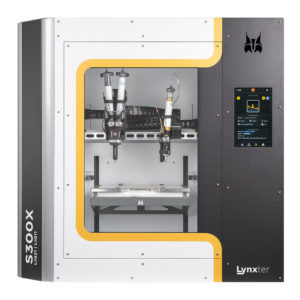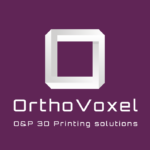1 – Can you tell me about your role and responsibilities within the company?
Since 2021, I have been a Research and Development Technician at COP Chimie. My primary role involves developing silicones specifically designed for 3D printing. I am also responsible for the 3D printing process, including prototype design, slicing, printer calibration, and post-processing of the produced parts. In collaboration with the sales department, I assess the feasibility and technical complexity of the projects to be undertaken
2 – How long have you been working with 3D printers, and what is your experience with silicones?
I have been working with 3D printers since 2013, exploring various technologies and materials, mainly thermoplastics. In 2021, my arrival at COP Chimie marked the beginning of my experience with silicone 3D printing, thanks to the Lynxter S600D printer and the partnership established with the company.
3 – How did the training for the new Lynxter S300X printer go?
The training on the new S300X printer was very enriching, allowing me to quickly master the new features and innovations. My previous experience with the former machine, the S600D, and silicone materials greatly facilitated this transition

4 – How did the installation of the machine go? Were there any particular challenges?
The installation of the S300X went smoothly and quickly, without major issues. I received support from the after-sales service, especially for the software installation, which simplified the entire process.
5 – What are your first impressions of the S300X?
The S300X has several notable innovations. The automatic calibration and purge system is particularly interesting, eliminating manual steps and the need to monitor the end of the print. The integration of a second extrusion head for printing water-soluble supports allows for the creation of new structures with complex shapes. Additionally, the new pumps are easier to clean, facilitating material changes. The machine is very user friendly, with a “Plug and Play” system that is a real asset.
6 – What silicones have you already developed?
Upon my arrival, I was trained in the formulation of silicones specifically intended for 3D printing, which allowed me to contribute to the development of our COPSIL 3D 4050, a skin-contact silicone with 40 Shore A hardness, high mechanical properties, and capable of achieving beautiful surface finishes in high-resolution printing. More recently, I also developed COPSIL 3D 0550 for low hardness applications, particularly in the healthcare sector. Additionally, I have had the opportunity to create many other specific formulations within the laboratory.
7 – What types of silicone prototypes have you produced so far with the S300X?
Among the prototypes produced, I printed a silicone mouthguard. As with any new piece, I had to perform several prints before achieving a satisfactory result. I produced a version on the S600D and another on the new S300X, using the integrated support technology. The piece obtained with the S300X has a significantly better finish thanks to this new technology
8 – Have you encountered any particular difficulties when creating prototypes with this printer? How do you assess the quality of the prints made with this new machine?
The various tests I have conducted so far are conclusive. The print quality is better,
notably thanks to the use of integrated water-soluble supports. I have not encountered any major difficulties when creating prototypes with this printer. Lynxter ensured the compatibility of our materials with their new extrusion system.
9 – Has this printer improved your efficiency or ability to handle more complex projects? If so, how?
The automation of certain processes of the printer has saved me time. I spend less time monitoring the print, which allows me to focus more on other aspects of the project.
10 – What are the main challenges encountered and/or specific limitations of silicone 3D printing with this machine?
The new machine presents some challenges and limitations. Being more compact, the print volume is therefore reduced. This limits the size of the pieces to be printed or requires reconsidering the design of the parts.
11 – Do you think this technology can revolutionize our approach to formulation? Why? How?
This new technology opens up new perspectives in our silicone manufacturing methods. It brings additional constraints to solve. The growing demand in our market, especially in the field of orthopedics, where silicone 3D printing allows for custom-made devices without impressions or molding, requires us to accumulate experience and knowledge in formulating these products.
12 – What advice would you give to other technicians starting to use this 3D printer for silicone printing?
The best advice I can offer is to consider the constraints (print volume, duration) and advantages (complex shape printing, filling) of 3D printing and the material from the design stage of the piece or prototype to be made.
For silicone, it is important to consider the potential collapse effects before the
material’s polymerization. However, thanks to the new integrated support technology, this issue can be circumvented with the support gel.










